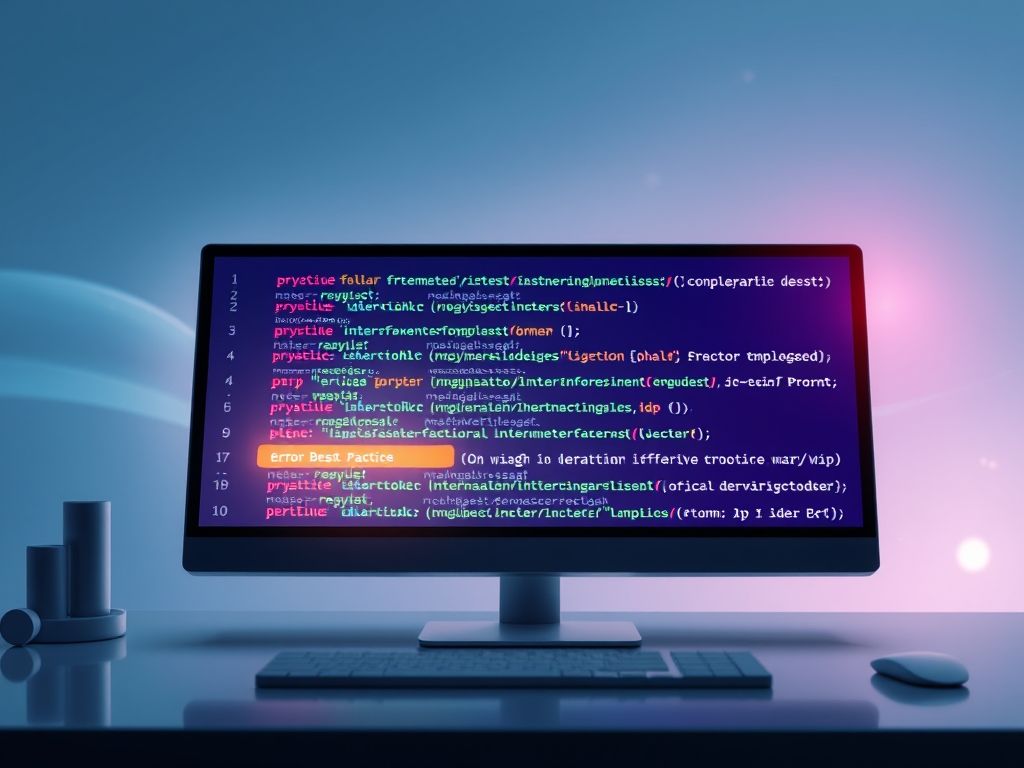PHP, a widely used server-side scripting language, is crucial for dynamic web development. This article provides essential tips for improving your PHP coding skills and enhancing your web applications. Learning these tips can significantly boost your efficiency and create more robust web solutions.
Chapter Title: Tip Lập Trình PHP: Best Practices
Here are the top 5 best practices for writing clean, efficient, and maintainable PHP code, contributing to building high-quality web applications. These practices directly impact the reliability and scalability of your projects, making them essential knowledge for any PHP developer looking to *cải thiện mã nguồn*.
1. **Embrace Object-Oriented Programming (OOP) Principles**:
OOP is a cornerstone of modern PHP development. By adhering to principles like encapsulation, inheritance, and polymorphism, you create modular and reusable code. Encapsulation bundles data and methods that operate on that data within a class, protecting it from outside interference and misuse. Inheritance allows you to create new classes based on existing ones, inheriting their properties and methods, thus reducing code duplication. Polymorphism enables objects of different classes to be treated as objects of a common type, promoting flexibility and extensibility.
Using OOP significantly improves the structure and maintainability of your code. For example, instead of writing procedural code that mixes business logic with presentation logic, you can create classes that represent different entities in your application, such as users, products, or orders. Each class can have its own methods for performing specific tasks related to that entity. This approach makes your code easier to understand, test, and modify.
2. **Follow Coding Standards (PSR)**:
PHP Standards Recommendations (PSR) are a set of guidelines developed by the PHP Framework Interoperability Group (PHP-FIG). These standards define how PHP code should be formatted and structured, covering aspects such as coding style, autoloading, and interfaces. Adhering to PSR standards ensures consistency across different projects and teams, making it easier for developers to collaborate and understand each other’s code.
The most commonly used PSR standards include PSR-1 (Basic Coding Standard), PSR-2 (Coding Style Guide), and PSR-4 (Autoloading Standard). PSR-1 defines basic rules for file naming, class naming, and method naming. PSR-2 builds on PSR-1 by adding more specific guidelines for code formatting, such as indentation, line length, and whitespace. PSR-4 specifies how to map class names to file paths, allowing you to automatically load classes when they are needed. Following these standards will greatly assist in *tip lập trình PHP*.
3. **Implement Proper Error Handling and Logging**:
Robust error handling is crucial for building reliable web applications. PHP provides various mechanisms for handling errors, including exceptions, error reporting, and custom error handlers. Exceptions allow you to gracefully handle unexpected situations, such as invalid input or database connection failures. Error reporting enables you to log errors and warnings to a file or display them on the screen, helping you identify and fix problems. Custom error handlers allow you to define your own functions for handling different types of errors.
Effective logging is equally important. By logging errors, warnings, and other important events, you can track down issues, monitor application performance, and gain insights into user behavior. Use a logging library like Monolog to simplify the process of logging messages to different destinations, such as files, databases, or email.
4. **Write Unit Tests**:
Unit testing involves testing individual units of code, such as functions or classes, in isolation. By writing unit tests, you can verify that your code works as expected and catch bugs early in the development process. PHPUnit is a popular unit testing framework for PHP that provides a rich set of features for writing and running tests.
Writing unit tests helps you improve the quality and maintainability of your code. It forces you to think about the different scenarios that your code might encounter and write code that is testable. It also makes it easier to refactor your code without introducing new bugs. Regular testing is a vital *tip lập trình PHP*.
5. **Optimize Database Queries**:
Database queries are often a bottleneck in web applications. Optimizing your queries can significantly improve the performance of your application. Use indexes to speed up data retrieval, avoid using `SELECT *` in your queries, and use prepared statements to prevent SQL injection attacks.
Profiling your queries can help you identify slow queries and optimize them. Tools like MySQL’s `EXPLAIN` statement can provide insights into how the database is executing your queries and identify potential areas for improvement. Efficient database interaction is key to successful *web development*.
These best practices are fundamental for professional PHP development. Implementing them will not only *cải thiện mã nguồn* but also enhance your ability to build scalable and maintainable web applications.
The next chapter will detail 3 common PHP coding errors and provide practical solutions for fixing them. It will also include examples of how these errors can affect the performance and security of web applications, focusing on specific techniques for improving code readability and maintainability.
Here’s the chapter, formatted as requested:
Cải thiện Mã Nguồn PHP
Following the “Tip Lập Trình PHP: Best Practices” discussed in the previous chapter, where we emphasized writing clean and maintainable PHP code, this chapter delves into common PHP coding errors and how to rectify them. Focusing on *cải thiện mã nguồn* (improving source code) is crucial for building robust and secure web applications. Identifying and fixing these errors early in the development process saves time and resources, and significantly enhances the performance and security of your *web development* projects.
Here, we’ll detail three prevalent PHP coding errors and provide practical solutions to address them.
1. SQL Injection Vulnerabilities
SQL injection is a critical security vulnerability that allows attackers to inject malicious SQL code into database queries. This can lead to unauthorized access, data modification, or even complete database takeover. This is a serious concern in *web development*, especially when user input is not properly sanitized.
* Error Description: Failing to sanitize user input before using it in SQL queries.
* Impact: Data breaches, data manipulation, and compromised system integrity.
* Solution: Use prepared statements with parameterized queries. Prepared statements separate the SQL code from the data, preventing attackers from injecting malicious code.
* Example:
Bad Code (Vulnerable to SQL Injection):
$username = $_POST['username'];
$query = "SELECT * FROM users WHERE username = '$username'";
$result = mysqli_query($conn, $query);
Good Code (Using Prepared Statements):
$username = $_POST['username'];
$stmt = mysqli_prepare($conn, "SELECT * FROM users WHERE username = ?");
mysqli_stmt_bind_param($stmt, "s", $username);
mysqli_stmt_execute($stmt);
$result = mysqli_stmt_get_result($stmt);
- Key Takeaway: Always use prepared statements or parameterized queries to protect against SQL injection attacks.
2. Ignoring Error Handling
PHP provides robust error handling mechanisms, but neglecting to implement them can lead to unexpected behavior and debugging nightmares. Proper error handling is essential for identifying and addressing issues in your code. This *tip lập trình PHP* (PHP programming tip) is often overlooked, but it is vital.
* Error Description: Not checking for errors after function calls or database operations.
* Impact: Application crashes, incorrect data processing, and difficulty in debugging.
* Solution: Use `try-catch` blocks for exception handling and check the return values of functions for errors. Enable error reporting in your PHP configuration.
* Example:
Bad Code (No Error Handling):
$result = mysqli_query($conn, "SELECT * FROM users");
while($row = mysqli_fetch_assoc($result)) {
echo $row['username'];
}
Good Code (With Error Handling):
$result = mysqli_query($conn, "SELECT * FROM users");
if (!$result) {
die("Query failed: " . mysqli_error($conn));
}
while($row = mysqli_fetch_assoc($result)) {
echo $row['username'];
}
- Key Takeaway: Implement comprehensive error handling to catch and address issues promptly.
3. Using Deprecated Functions
PHP evolves, and some functions become deprecated over time. Using deprecated functions can lead to compatibility issues and security vulnerabilities.
* Error Description: Using functions marked as deprecated in the PHP documentation.
* Impact: Code breaking in future PHP versions, potential security risks, and reduced performance.
* Solution: Regularly review your code for deprecated functions and replace them with their recommended alternatives. Consult the PHP documentation for the latest updates and best practices.
* Example:
Bad Code (Using Deprecated `mysql_*` functions):
$conn = mysql_connect("localhost", "user", "password");
mysql_select_db("database", $conn);
$result = mysql_query("SELECT * FROM users");
Good Code (Using `mysqli_*` or PDO):
$conn = mysqli_connect("localhost", "user", "password", "database");
$result = mysqli_query($conn, "SELECT * FROM users");
- Key Takeaway: Stay updated with PHP’s evolution and avoid using deprecated functions.
By addressing these common PHP coding errors, developers can significantly improve the quality, security, and performance of their *web development* projects. Continuously reviewing and *cải thiện mã nguồn* (improving source code) is a crucial aspect of professional PHP development.
In the next chapter, we will explore how PHP integrates with other web development technologies, such as databases and frameworks (“PHP & Web Development: Integration”). We’ll discuss how to use PHP to interact with a database and build dynamic web pages using a suitable framework, emphasizing the importance of security best practices when integrating PHP with external resources.
Here’s the chapter content:
PHP & Web Development: Integration
Building upon the principles of *cải thiện mã nguồn* (improving source code) discussed earlier, particularly addressing common PHP coding errors and enhancing code readability and maintainability, this chapter delves into how PHP seamlessly integrates with other essential web development technologies. Specifically, we’ll explore its interaction with databases and frameworks, emphasizing security best practices.
PHP’s strength lies in its ability to create dynamic web applications, and this dynamism is often achieved through database interaction. Let’s consider connecting to a MySQL database using PHP. The `mysqli` extension is a common choice. Here’s a basic example:
“`php
connect_error) {
die(“Connection failed: ” . $conn->connect_error);
}
$sql = “SELECT id, firstname, lastname FROM MyGuests”;
$result = $conn->query($sql);
if ($result->num_rows > 0) {
// output data of each row
while($row = $result->fetch_assoc()) {
echo “id: ” . $row[“id”]. ” – Name: ” . $row[“firstname”]. ” ” . $row[“lastname”]. “
“;
}
} else {
echo “0 results”;
}
$conn->close();
?>
“`
This code snippet demonstrates a simple database connection, query execution, and result display. However, it’s crucial to implement security measures. Directly embedding credentials in the code is a security risk. Instead, use environment variables or configuration files to store sensitive information. Furthermore, always sanitize user inputs to prevent SQL injection attacks. Prepared statements are a powerful tool for this:
“`php
connect_error) {
die(“Connection failed: ” . $conn->connect_error);
}
// prepare and bind
$stmt = $conn->prepare(“SELECT id, firstname, lastname FROM MyGuests WHERE firstname = ?”);
$stmt->bind_param(“s”, $firstname);
// set parameters and execute
$firstname = $_POST[‘firstname’];
$stmt->execute();
$result = $stmt->get_result();
if ($result->num_rows > 0) {
// output data of each row
while($row = $result->fetch_assoc()) {
echo “id: ” . $row[“id”]. ” – Name: ” . $row[“firstname”]. ” ” . $row[“lastname”]. “
“;
}
} else {
echo “0 results”;
}
$stmt->close();
$conn->close();
?>
“`
Modern *web development* often utilizes frameworks, which provide structure and reusable components, accelerating the development process. Laravel is a popular PHP framework known for its elegant syntax and robust features. Consider a simple example of displaying data from a database using Laravel’s Eloquent ORM:
“`php
$users]);
}
}
“`
In this example, `User::all()` retrieves all users from the database. The data is then passed to a view, which handles the presentation. Laravel also provides built-in security features, such as protection against cross-site scripting (XSS) and cross-site request forgery (CSRF) attacks.
Here are some key points to remember when integrating PHP with external resources:
- Always sanitize user inputs to prevent injection attacks.
- Use prepared statements for database interactions.
- Store sensitive information securely, avoiding hardcoding credentials.
- Implement proper authentication and authorization mechanisms.
- Keep your PHP version and libraries up to date to patch security vulnerabilities.
- Regularly review your code for potential security flaws.
These practices contribute significantly to *tip lập trình PHP* (PHP programming tips) that enhance security. Understanding how PHP interacts with databases and frameworks is essential for building robust and secure web applications. Ignoring these principles can lead to vulnerabilities that compromise your application and user data.
The next chapter will explore advanced PHP techniques for optimizing performance, focusing on caching strategies and code profiling.
Conclusions
Mastering PHP coding techniques empowers developers to build robust, scalable, and secure web applications. By consistently applying these best practices, you can enhance your coding efficiency and create high-quality web solutions. Further explore advanced PHP concepts to expand your skills even further.











